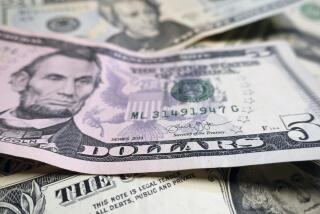Dollar poised for worst first 100 days of presidency since Nixon

- Share via
A dollar gauge is on track for its worst performance during the first 100 days of a U.S. presidency in data going back to the Nixon era, when America abandoned the gold standard and switched to a free-floating exchange rate.
The U.S. dollar index has lost about 9% between Jan. 20 — when Donald Trump returned to the White House — and April 25, putting it on course for the biggest loss through the end of the month since at least 1973.
The president’s first 100 days in office in recent decades have been marked by strength in the country’s currency, with returns averaging close to 0.9% between 1973, when Richard Nixon began his second term, and 2021, when Joe Biden took office.
Meant as a temporary measure, the so-called Nixon shock of 1971 caused the dollar to drop, effectively ending the Bretton Woods system of fixed exchange rates established after the end of World War II.
Trump during the early innings of his second presidency followed through on various campaign pledges, introducing new tariffs and dialing up the rhetoric against China and other U.S. trading partners. His tariff policy has led investors to pile into assets outside the United States, weakening the greenback and lifting other currencies alongside gold.
The euro, Swiss franc and yen have risen more than 8% each against the dollar since Trump’s return to the presidency.
“The ubiquity of the U.S. dollar and its role in international trade and finance came with deep trust in U.S. institutions, low trade and capital barriers as well as a predictable foreign policy,” said Bipan Rai, a managing director at BMO Global Asset Management.
“Now? There are clear signs of erosion which points to change in global asset allocation trends which don’t favor the U.S. dollar. We sense this is a structural shift,” he said.
Trump’s policy initiatives have also increased the risk of a U.S. recession combined with reaccelerating inflation, limiting the scale of potential interest rate cuts by the Federal Reserve.
The president’s comments about Fed Chair Jerome Powell — especially his threat to fire him — have put investors on alert, elevating concerns over the U.S. central bank’s independence. Trump later said he had no intention of firing Powell.
UBS Group AG as a result cut its dollar forecast for the second time in less than two months. Analysts stated that the greenback’s performance hinges on the outcome of the U.S.-China standoff, which hasn’t seen much progress in recent weeks.
Deutsche Bank AG this week warned of a structural downtrend for the dollar in the coming years, which could knock the U.S. currency to its weakest level in more than a decade against the euro.
Speculative traders, including hedge funds and asset managers, have increased their bets against the dollar in April. The group is the most short dollar since September, with bearish bets on the U.S. currency worth about $13.9 billion during the week ended April 22, according to data from the Commodity Futures Trading Commission.
Lei and Andrianova write for Bloomberg.
More to Read
Inside the business of entertainment
The Wide Shot brings you news, analysis and insights on everything from streaming wars to production — and what it all means for the future.
You may occasionally receive promotional content from the Los Angeles Times.










